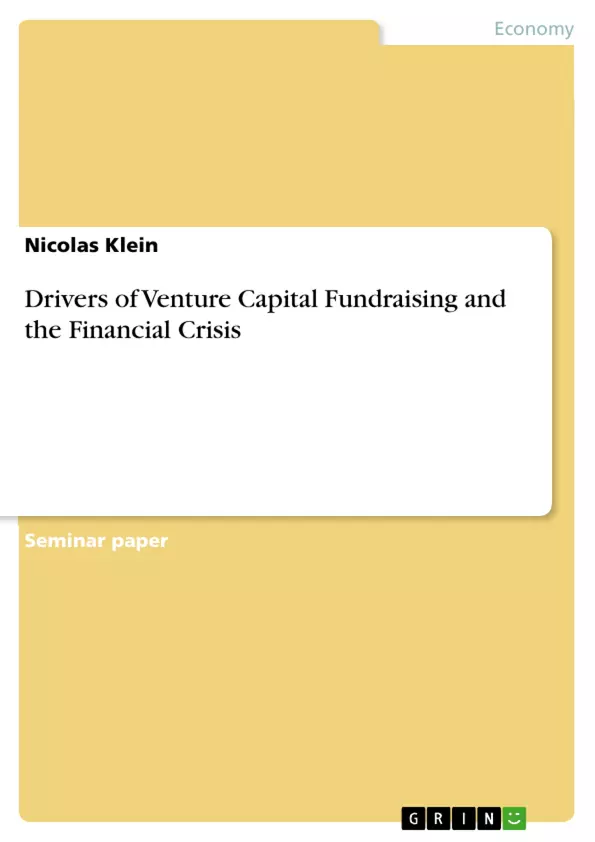This paper gives an overview on the main drivers for venture capital fundraising, and their impact on the supply and demand side of investments. First the differences between captive and independent venture capital firms and the difference between the supply and demand of venture capital investment are explained to prevent misunderstandings. The determinants of venture capital fundraising identified here are the Initial Public Offering, the overall economic growth, the capital gains tax rates, the labor market conditions, the financial reporting requirements, the firm’s specific performance and reputation, the existence and regulatory changes of private pension funds and governmental activities and support programs. In addition the impact of the financial crisis on venture capital fundraising has been identified and analyzed in four categories. The risk aversion as a consequence of the financial crisis, the decrease of valuation of venture capital-backed startups, the reduced interest rates and new restrictions and laws designed to protect countries and markets against future financial crisis.
Inhaltsverzeichnis (Table of Contents)
- INTRODUCTION
- Definition of Venture Capital
- Independent vs. captive venture capital firms
- Supply and demand effects on VCF
- DETERMINANTS OF VCF
- IPO
- Overall economic growth
- Capital gains tax rates
- Labor market conditions
- Financial reporting requirements
- Firm's specific performance and reputation
- Private pension funds
- Governmental activities and support programs
- IMPACTS OF THE FINANCIAL CRISIS ON VCF
- Risk aversion
- Decrease of valuation of venture capital-backed startups
- Reduction of interest rates
- New restrictions and laws
- CONCLUSION
Zielsetzung und Themenschwerpunkte (Objectives and Key Themes)
This paper explores the primary drivers of venture capital fundraising (VCF) and analyzes the impact of the financial crisis on VCF. The study aims to understand the factors influencing VCF, differentiate between supply and demand effects, and investigate the consequences of the financial crisis on this crucial aspect of early-stage financing.- Defining venture capital and its role in innovation
- Analyzing the differences between independent and captive venture capital firms
- Examining the impact of the financial crisis on venture capital fundraising
- Identifying the key determinants of venture capital fundraising
- Exploring the relationship between VCF and economic growth
Zusammenfassung der Kapitel (Chapter Summaries)
- Introduction: This chapter provides a comprehensive overview of venture capital, outlining its definition, significance in driving innovation, and the key distinction between independent and captive venture capital firms. The chapter also introduces the concept of supply and demand effects on venture capital fundraising, highlighting the complexities of this dynamic.
- Determinants of VCF: This chapter delves into the crucial factors influencing venture capital fundraising. It explores the impact of IPOs, overall economic growth, capital gains tax rates, labor market conditions, financial reporting requirements, firm performance and reputation, private pension funds, and governmental support programs on VCF.
- Impacts of the Financial Crisis on VCF: This chapter analyzes the profound consequences of the financial crisis on venture capital fundraising. It examines how risk aversion, decreased valuation of venture-backed startups, reduction in interest rates, and new regulatory restrictions have significantly impacted VCF.
Schlüsselwörter (Keywords)
This paper focuses on venture capital fundraising (VCF), exploring its key determinants and the impact of the financial crisis. Key themes include the role of venture capital in innovation, the distinction between independent and captive venture capital firms, the impact of economic growth on VCF, and the consequences of the financial crisis on this critical financing mechanism.- Quote paper
- Nicolas Klein (Author), 2010, Drivers of Venture Capital Fundraising and the Financial Crisis, Munich, GRIN Verlag, https://www.grin.com/document/182488



